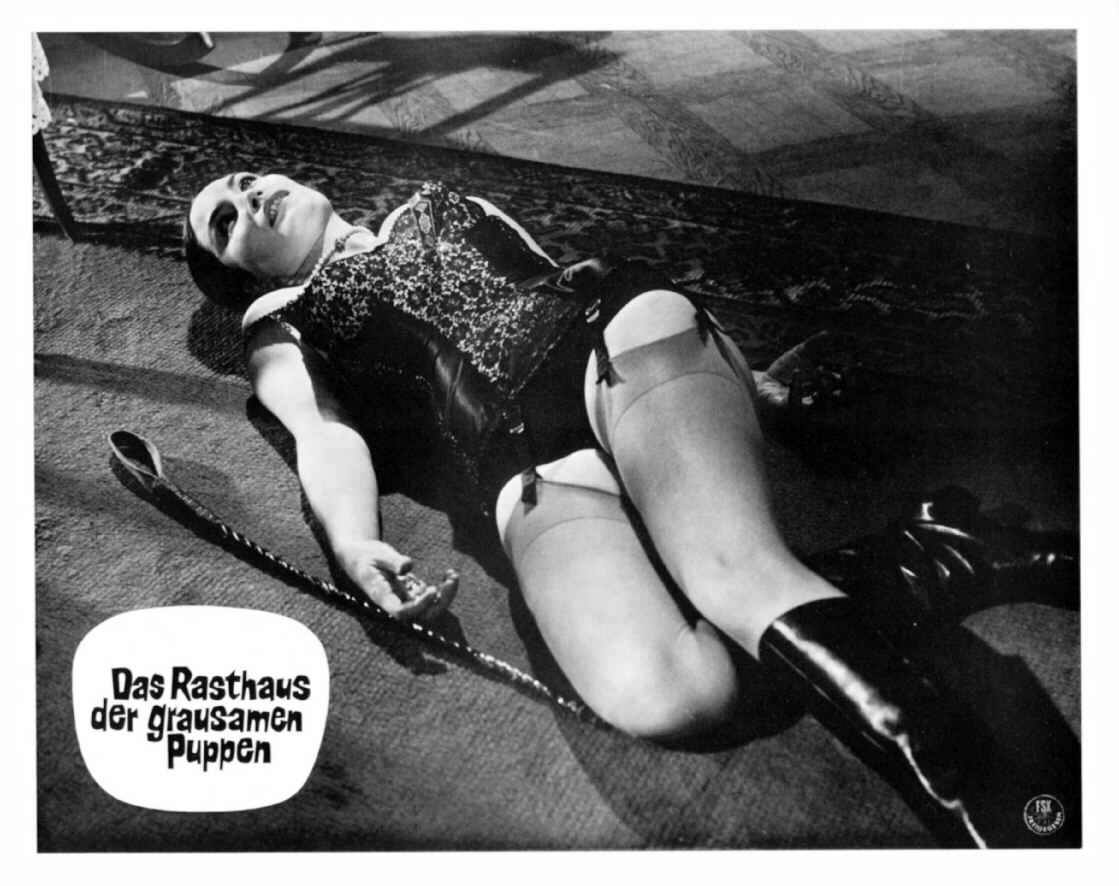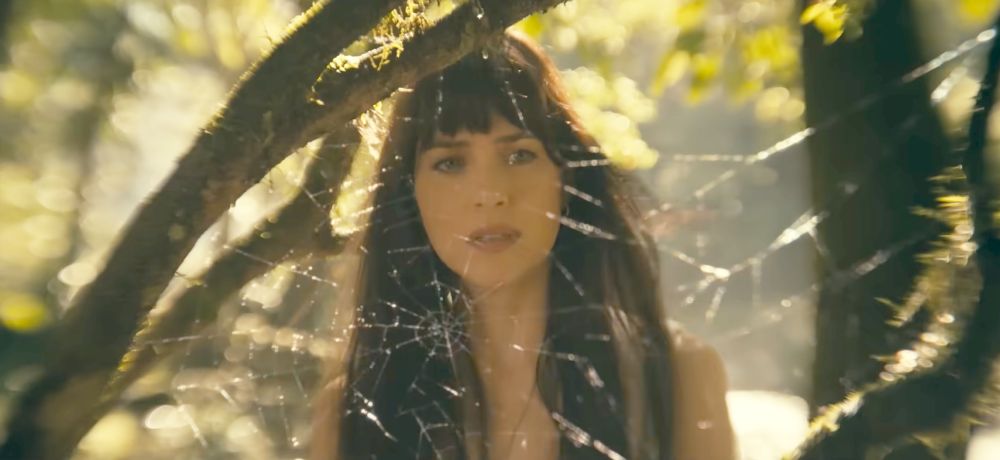 ★★★
★★★
“Adventures in Babysitting.”
Having read quite a number of articles on (p)reviews for this movie and now having seen it myself, I’m beginning to think you can buy negative reviews to torpedo product that might compete with yours. I’ve seen this before, e. g. when the press tore down John Carter so that The Hunger Games could become the defining blockbuster franchise of the decade. Or when it became very obvious Disney had ties to RottenTomatoes.com: the Internet may recall this as the “Great Captain Marvel online war” :) It seems this takes place in particular with comic-book or superhero movies not from Disney/Marvel. It happened regularly with the X-Men movies, when 20th Century Fox still existed as an independent studio. It happened when the – admittedly, very often not so good – DC movies came out: neither Black Adam nor Aquaman 2 were as bad as the reviews made them.
And now, it seems to happen with “Sony’s Spider-Man Universe” (SSU). That the quality of these vary greatly is not in question. Of course they do. While the Spider-Man films with Tom Holland are beloved by fans, and seem to be well-regarded by critics, things don’t look so bright for the extended universe Sony is building. The first Venom movie with Tom Hardy was torn down by the media, but cheered by the cinema-going masses; the second was similarly split. Then Morbius with Jared Leto got almost entirely negative reviews and that trend continues with Madame Web. Things don’t look good for Kraven the Hunter, another entry in the universe due out later this year.
I’ll be honest and admit it: Madame Web is not a great cinematic revelation, it’s definitely not the “must-see” superhero film of the year and probably won’t blow your socks off. But – and this is where I feel I get justifiably angry – “not great” is not the same as “bad”. I’m coming to the conclusion you can’t trust sites like Rotten Tomatoes, and you shouldn’t read reviews before you watch. A movie review (and this counts for mine too) can’t tell if you will like a movie or not. Follow your instinct and make up your own mind, that’s my friendly advice to the dedicated film-goer. This is not to say Madame Web is perfect entertainment. But I will defend it against anyone saying it is a “bad” movie. You may call it bland, boring or mediocre if you like, but that’s not the same. I’ve seen enough bad movies in my lifetime to know, bad looks very different.
So, what’s up with Madame Web? The film starts in the South American jungle, where pregnant scientist Constance (Kerry Bishé) seeks a specific spider for its medical uses, but is killed by assistant Ezekiel Sims (Tahar Rahim), who wants the spider for himself. Apparently – though it is never explained how – he uses it to become a wealthy and still astonishingly young looking man (this prologue happens in 1973, than jumps to 2003, so he should be around 60?). The so-called “spider people” can’t save Constance, who was bitten by a spider before giving birth, but give her daughter up for adoption.
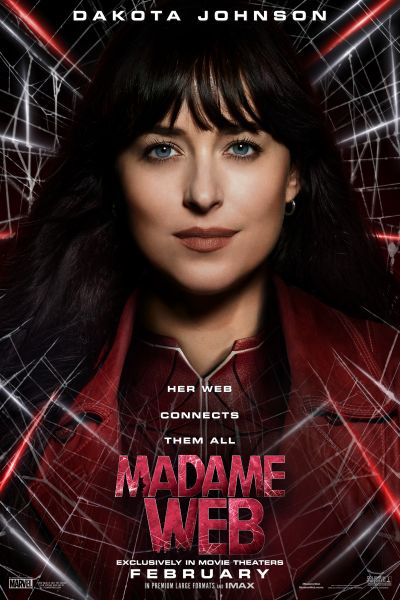 Jump forward to 2003. Cassandra “Cassy” Webb (Johnson), Constance’s daughter, is a paramedic who saves lives everyday, but is strongly averse to emotional attachment. I wondered what she does in her leisure time – but then, the same could be said about me! After being drowned, dead for three minutes, and revived, she has visions which turn out to be clairvoyant; she can glimpse the future moments before it happens. After experiencing the death of a colleague, she realizes she can act to stop her visions taking place. [What a revelation!] While on a train she foresees the death of three girls, killed by a masked man with superpowers. She tries her best to save them; no easy job as she has to improvise and out-think her pursuer constantly, while taking care of young girls who don’t necessarily follow her orders. That’s the moment you realize this movie might be made with 30-year-old moms as its target audience, which is something I have not seen before on the big screen.. Kudos for originality, I think.
Jump forward to 2003. Cassandra “Cassy” Webb (Johnson), Constance’s daughter, is a paramedic who saves lives everyday, but is strongly averse to emotional attachment. I wondered what she does in her leisure time – but then, the same could be said about me! After being drowned, dead for three minutes, and revived, she has visions which turn out to be clairvoyant; she can glimpse the future moments before it happens. After experiencing the death of a colleague, she realizes she can act to stop her visions taking place. [What a revelation!] While on a train she foresees the death of three girls, killed by a masked man with superpowers. She tries her best to save them; no easy job as she has to improvise and out-think her pursuer constantly, while taking care of young girls who don’t necessarily follow her orders. That’s the moment you realize this movie might be made with 30-year-old moms as its target audience, which is something I have not seen before on the big screen.. Kudos for originality, I think.
Some changes from the comics were obvious. I’m no expert on all things and characters around Spider-Man but last time I saw Madame Web, was a 90’s animated series where she was an old, blind woman in a wheel-chair, She controlled the web of time and sent ol’ Spidey on a mission. This film goes full circle, having Cassie at the end in a wheel-chair and wearing dark glasses – enough time to age, when she needs to appear in a Spidey movie playing 20-something years in the future. Also, the three girls who will be Spider-Women and -Girls of the future (played by Sweeney, O’Connor and Merced) are not really characters I know. Having had a thing for the Spider-Woman comic an eternity ago, I remember that Mattie Franklin was white and the niece of J. Jonah Jameson. Here she is black and her background has totally changed. I guess the aim is to be as diverse as possible.
I personally don’t mind a movie centered on female characters in the Spider-Man universe. Heck, for decades I’ve been waiting for a Black Cat or Silver Sable movie, though right now that prospect seems quite dim considering the reaction here. But having this movie precede the Tom Holland Spider-Man does give me the feeling this is another attempt to give a hero’s tale a backstory based on an earlier woman (as done terribly by British TV classic Doctor Who). That said, this movie is not “woke”. Yes, the villain is a man but there is no male-bashing or ridiculing, as has become so common nowadays e. g. by Disney. It just puts female characters at the focus of the story and that’s absolutely okay by me.
What did surprise me is the main protagonist. Madame Web is neither one of many charismatic villains the Spidey-universe offers, nor what I’d call a “hero”. Making her the center of the story is a gamble, with the need for a scenario where she becomes the main character. Which the screenplay does quite well, I’d say. It would have been easier to make a movie about the Spider-Women or Spider-Girl, but here we are. Also, the title character has no super-powers which are interesting to watch. She can’t crawl up walls, jump from roof to roof, or has super-strength. She can just see a bit into the future. That’s it, until the end when she develops the ability to be in several places at once to help her girls (yeah, it’s definitely a movie for moms!). It means the screenwriters really had to think hard to provide the necessary action. and have their protagonist use her wits to counter her opponent, who unfairly uses early face-identifying computer programs to find the three girls.
A word on the actors. Dakota Johnson (daughter of Don Johnson and Melanie Griffith, granddaughter of Tippi Hedren) has long left the memories of her early Fifty Shades of Grey success behind her. She is a good, professional actress and I’ve never seen a bad performance from her. This movie is no exception. The “girl” actresses don’t register strongly here; their characters are hardly given much to do here, which can be considered a weakness of the script, except being kind of a pain in Cassie’s neck. Tahar Rahim as the villain, comes across a bit bland which might not be the actor’s fault – the character is just not very interesting. His main goal is to stop these girls, who may become dangerous for him later. Ironically, as Cassie realizes, it’s exactly this fear of the future which leads to his downfall here and now, at her hands.
Once again, I stress Madame Web is not a bad movie. It may be too long – though less than some of the bloated blockbusters Hollywood produces nowadays. It could have a more interesting villain, with better motivation. They could have chosen a more interesting main character. But if there is one real problem with all the new SSU movies, it is the lack of humor. A bit of it, integrated into the heroine’s or villain’s character, would go a long way in making a superhero movie a more entertaining product. But maybe that’s not the route Sony wants to go, perhaps to distance themselves from the style of Marvel. It would be regrettable: a surprise hit like Venom showed how that element is appreciated by audiences. If you give them drama, action and suspense, they must also have the chance to let go of the tension with laughter. An approach classic James Bond movies employed, to good effect, at the beginning of the action movie genre.
All in all, the movie, its direction, script, acting performances, etc., are solid. Not great. Also not terrible. It is an acceptable solid superhero comic-book movie, though the superhero thing comes across here as toned down. Just don’t expect the big typical blockbuster epic that too many people may nowadays associate with the genre. Who knows? If Sony continues in this manner maybe they can actually get their SSU to work for the large audience? If not, I imagine they can still put all of these newly released characters in the next Spider-Man movie with Tom Holland!
Dir: S. J. Clarkson
Star: Dakota Johnson, Sydney Sweeney, Isabela Merced, Celeste O’Connor
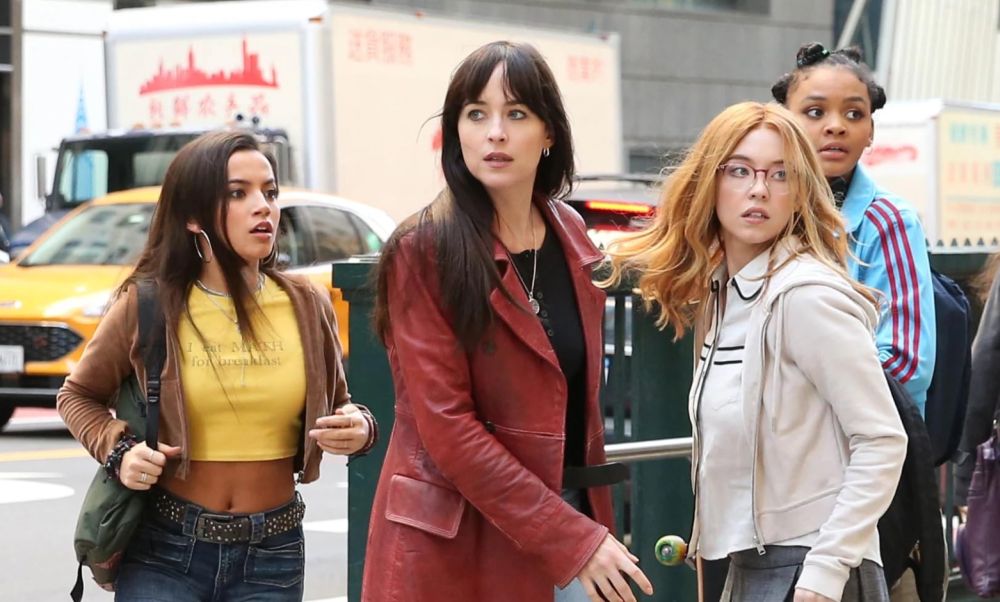





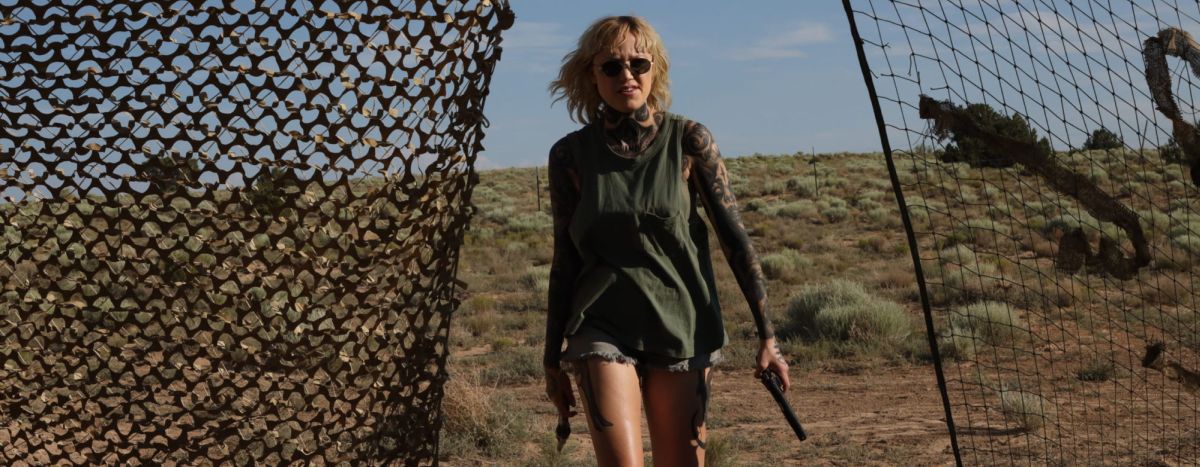 ★★★★
★★★★ To be honest, I never read Boston Teran’s novel. I wasn’t aware of the story until this movie came out here on DVD – but then the book was also never released in my country. I’ve every intention to read it and have already ordered it in English. However, I can’t make any comparisons between the book and the movie adaptation, directed by Nick Cassavetes, son of John Cassavetes.
To be honest, I never read Boston Teran’s novel. I wasn’t aware of the story until this movie came out here on DVD – but then the book was also never released in my country. I’ve every intention to read it and have already ordered it in English. However, I can’t make any comparisons between the book and the movie adaptation, directed by Nick Cassavetes, son of John Cassavetes.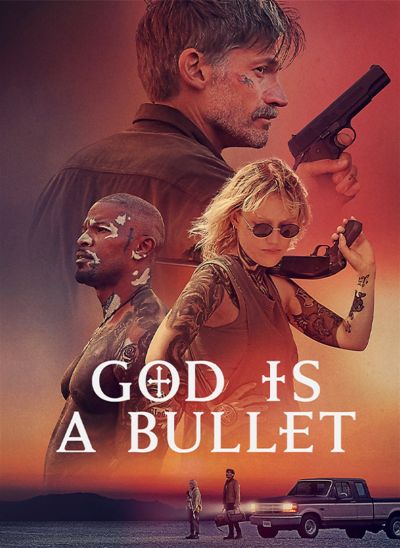 It’s the most fulfilling part of the movie. In a way, Case is Bob’s guarding angel; she knows about those people, how they behave, how to deal with them, also the danger that they embody as human life has hardly any value for them. Bob goes “undercover” to find his daughter which also means he has to look and appear like these people, so gets a full-body tattoo by “The Ferryman” (Foxx in a larger supporting role). The aim is to contact the sect, whose cult leader Cyrus (Glusman) is a specific piece of human scum, and deal with him. All of what has happened ties back to Bob’s father in law and his superior at the police office, though he doesn’t know this.
It’s the most fulfilling part of the movie. In a way, Case is Bob’s guarding angel; she knows about those people, how they behave, how to deal with them, also the danger that they embody as human life has hardly any value for them. Bob goes “undercover” to find his daughter which also means he has to look and appear like these people, so gets a full-body tattoo by “The Ferryman” (Foxx in a larger supporting role). The aim is to contact the sect, whose cult leader Cyrus (Glusman) is a specific piece of human scum, and deal with him. All of what has happened ties back to Bob’s father in law and his superior at the police office, though he doesn’t know this.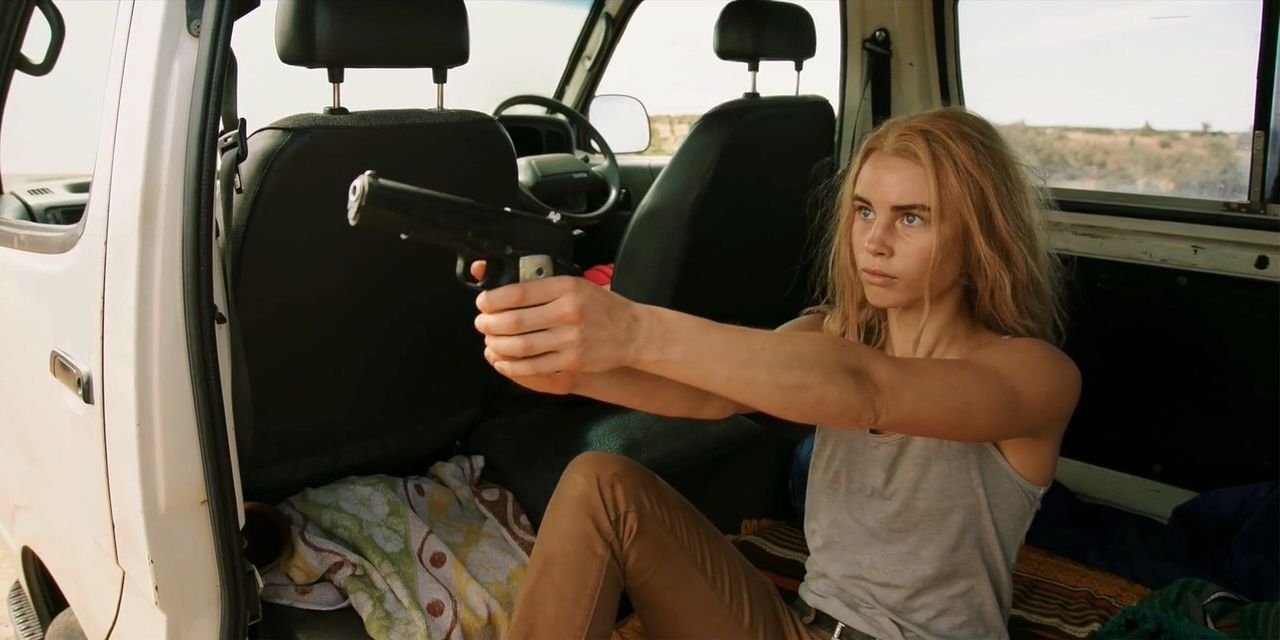 ★★★★
★★★★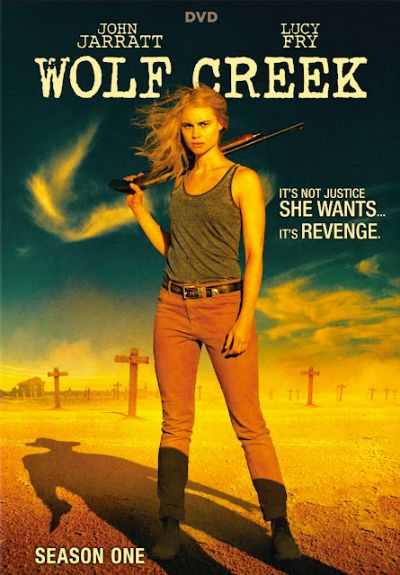 I have to say that this series really surprised me. I had bought it based solely due to the cool cover photo and didn’t expect much more than a probably over-gruesome third-rate slasher, I mean, is Australia really famous for great serial killer psycho thrillers? Though there is the very good Stacy Keach and Jamie Lee Curtis thriller from 1981, Road Games. As a matter of fact, this short (six episodes) series blew me away with its astounding quality. When you read the above, you might be forgiven for getting the impression the whole thing will come across as a bit cheap in its storytelling, or the motivation of its characters – a bit schlocky in general.
I have to say that this series really surprised me. I had bought it based solely due to the cool cover photo and didn’t expect much more than a probably over-gruesome third-rate slasher, I mean, is Australia really famous for great serial killer psycho thrillers? Though there is the very good Stacy Keach and Jamie Lee Curtis thriller from 1981, Road Games. As a matter of fact, this short (six episodes) series blew me away with its astounding quality. When you read the above, you might be forgiven for getting the impression the whole thing will come across as a bit cheap in its storytelling, or the motivation of its characters – a bit schlocky in general. Eve is repeatedly confronted by these criminals, or wanna-be-rapists who see a normal dressed woman as an offer, and experiences family tragedies that actually form the core of the narrative. She is not without help though. As well as the policeman on her trail who reluctantly starts to cover-up for her, there is a criminal whom she meets in the desert, an old Aborigine who fits into the classic mentor role, a colleague in a bar and she even gets a canine companion. Though the question always lingers while watching the show: Will she get her revenge? What will she do when meeting the man who killed her family? Does she even have a chance against an experienced, sadistic killer like Mick?
Eve is repeatedly confronted by these criminals, or wanna-be-rapists who see a normal dressed woman as an offer, and experiences family tragedies that actually form the core of the narrative. She is not without help though. As well as the policeman on her trail who reluctantly starts to cover-up for her, there is a criminal whom she meets in the desert, an old Aborigine who fits into the classic mentor role, a colleague in a bar and she even gets a canine companion. Though the question always lingers while watching the show: Will she get her revenge? What will she do when meeting the man who killed her family? Does she even have a chance against an experienced, sadistic killer like Mick?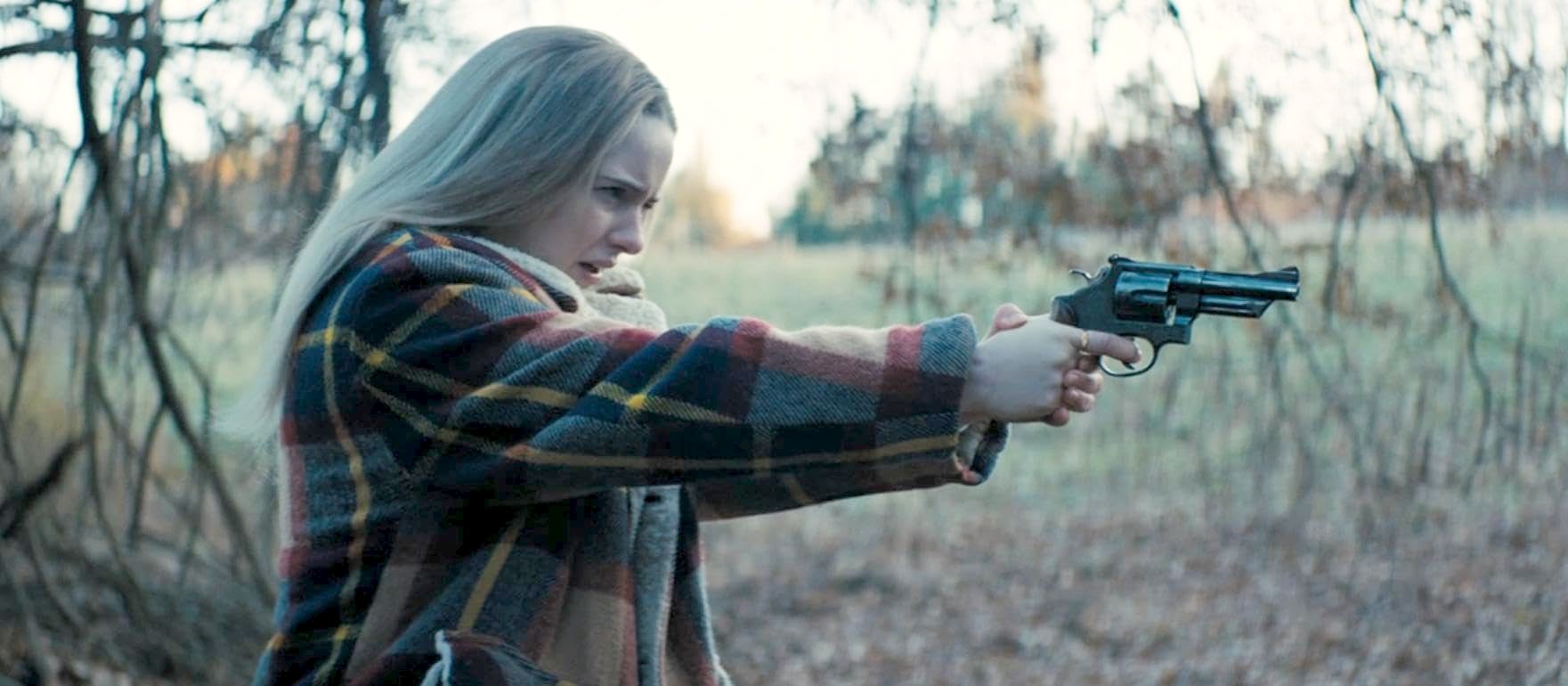 ★★★★
★★★★ I think this makes it quite an unusual movie as – in contrast to many other movies – we are not immediately brought up to speed with an info-dump, so that we tie ourselves emotionally to Jean. As a result, the fear and tension she experiences are really palpable to us, too. We don’t know who Cal is and why he is helping her, or why people are after Jean. In my opinion, the movie is particularly successful in showing a female perspective, as part of something that would otherwise potentially have been just an ordinary gangster story. In the beginning, Jean does whatever she is told, while at the same time also trying her best to be a good mother to the little baby, even if her knowledge in this respect is also just rudimentary.
I think this makes it quite an unusual movie as – in contrast to many other movies – we are not immediately brought up to speed with an info-dump, so that we tie ourselves emotionally to Jean. As a result, the fear and tension she experiences are really palpable to us, too. We don’t know who Cal is and why he is helping her, or why people are after Jean. In my opinion, the movie is particularly successful in showing a female perspective, as part of something that would otherwise potentially have been just an ordinary gangster story. In the beginning, Jean does whatever she is told, while at the same time also trying her best to be a good mother to the little baby, even if her knowledge in this respect is also just rudimentary.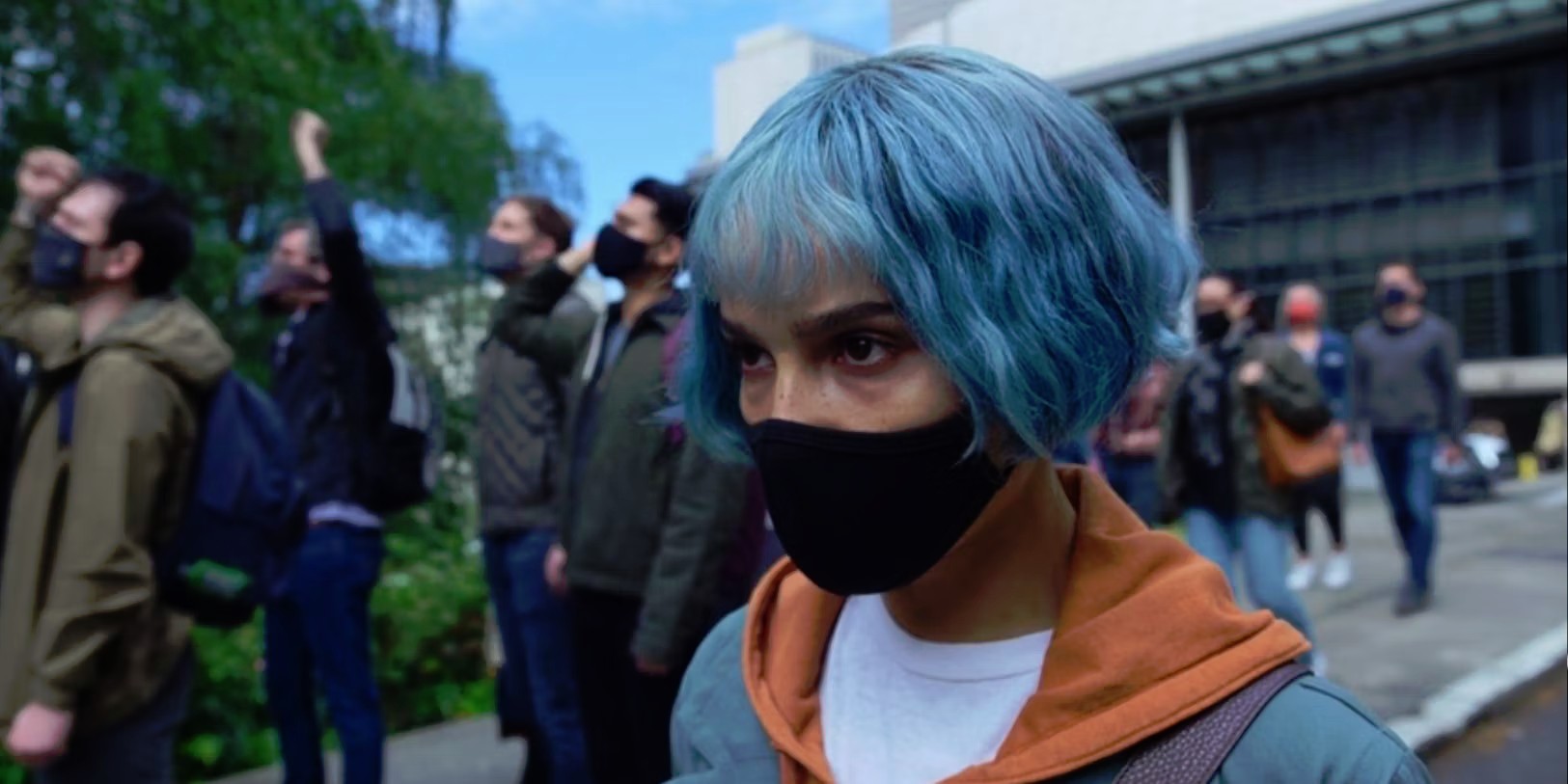 ★★★
★★★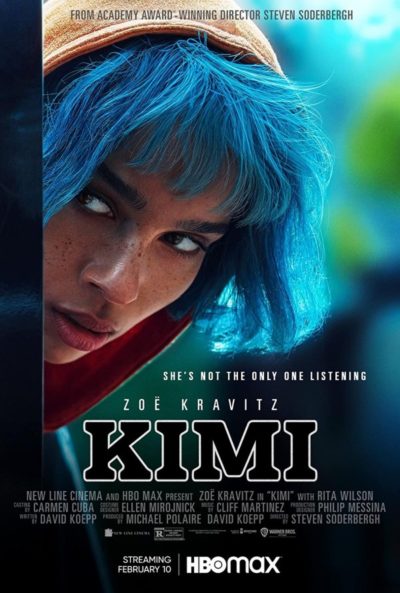 Kimi indirectly discusses this attitude, but also seems to make a clear point that there is a need to leave your own four walls sometimes, because not everything can be handled from your laptop. That said, it’s quite disturbing how much
Kimi indirectly discusses this attitude, but also seems to make a clear point that there is a need to leave your own four walls sometimes, because not everything can be handled from your laptop. That said, it’s quite disturbing how much  ★★★½
★★★½ While the other girls might be complicated and have problems, like feeling unloved, being shy and, in one case, not even being into men, there always was a solution. Kurumi is… different: Shido soon found out she was there to sexually arouse him, so she could “eat him”. We can argue about the not-so subtle subtext: male Japanese anxiety about a sexually demanding and active woman. In the very same episode, some boys make sexually charged comments about her, she lures them into the shadows… next the blood is dripping from the walls.
While the other girls might be complicated and have problems, like feeling unloved, being shy and, in one case, not even being into men, there always was a solution. Kurumi is… different: Shido soon found out she was there to sexually arouse him, so she could “eat him”. We can argue about the not-so subtle subtext: male Japanese anxiety about a sexually demanding and active woman. In the very same episode, some boys make sexually charged comments about her, she lures them into the shadows… next the blood is dripping from the walls.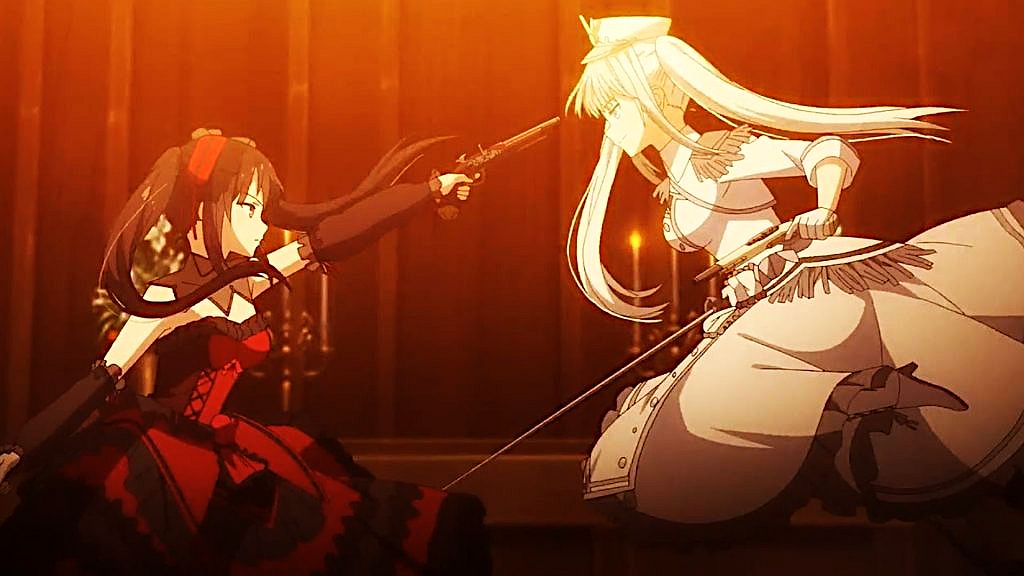
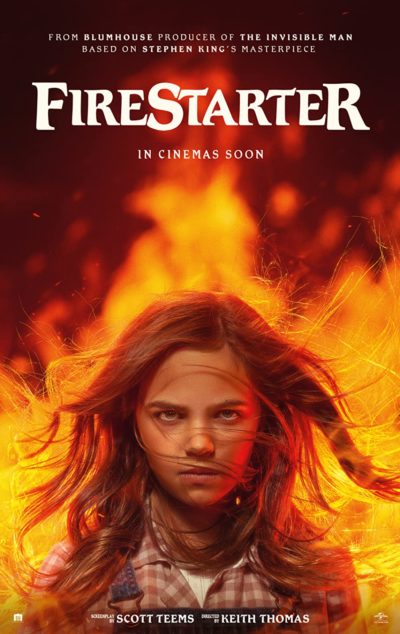 I must admit: While I always found the premise for Stephen King’s 1980 novel Firestarter interesting, I never read the book. 500 small-printed pages are just too much for me. The story itself shares some of its DNA with Carrie, with the difference that this here is about a younger child, not an adolescent, and instead of telekinesis the girl knows pyrokinesis, meaning she can create fire from nowhere and control it. It could be argued that King was just kind of re-using ideas from Carrie, making less of an effort to create something original as he did with other material. Opinions on the story seem to be split. Some think it’s a great novel, of the usual King quality; others think it’s a typical work from the time when King was writing as if he were on the run, and striking while the iron was hot (honestly, I don’t really see he has slowed down so much over the years).
I must admit: While I always found the premise for Stephen King’s 1980 novel Firestarter interesting, I never read the book. 500 small-printed pages are just too much for me. The story itself shares some of its DNA with Carrie, with the difference that this here is about a younger child, not an adolescent, and instead of telekinesis the girl knows pyrokinesis, meaning she can create fire from nowhere and control it. It could be argued that King was just kind of re-using ideas from Carrie, making less of an effort to create something original as he did with other material. Opinions on the story seem to be split. Some think it’s a great novel, of the usual King quality; others think it’s a typical work from the time when King was writing as if he were on the run, and striking while the iron was hot (honestly, I don’t really see he has slowed down so much over the years).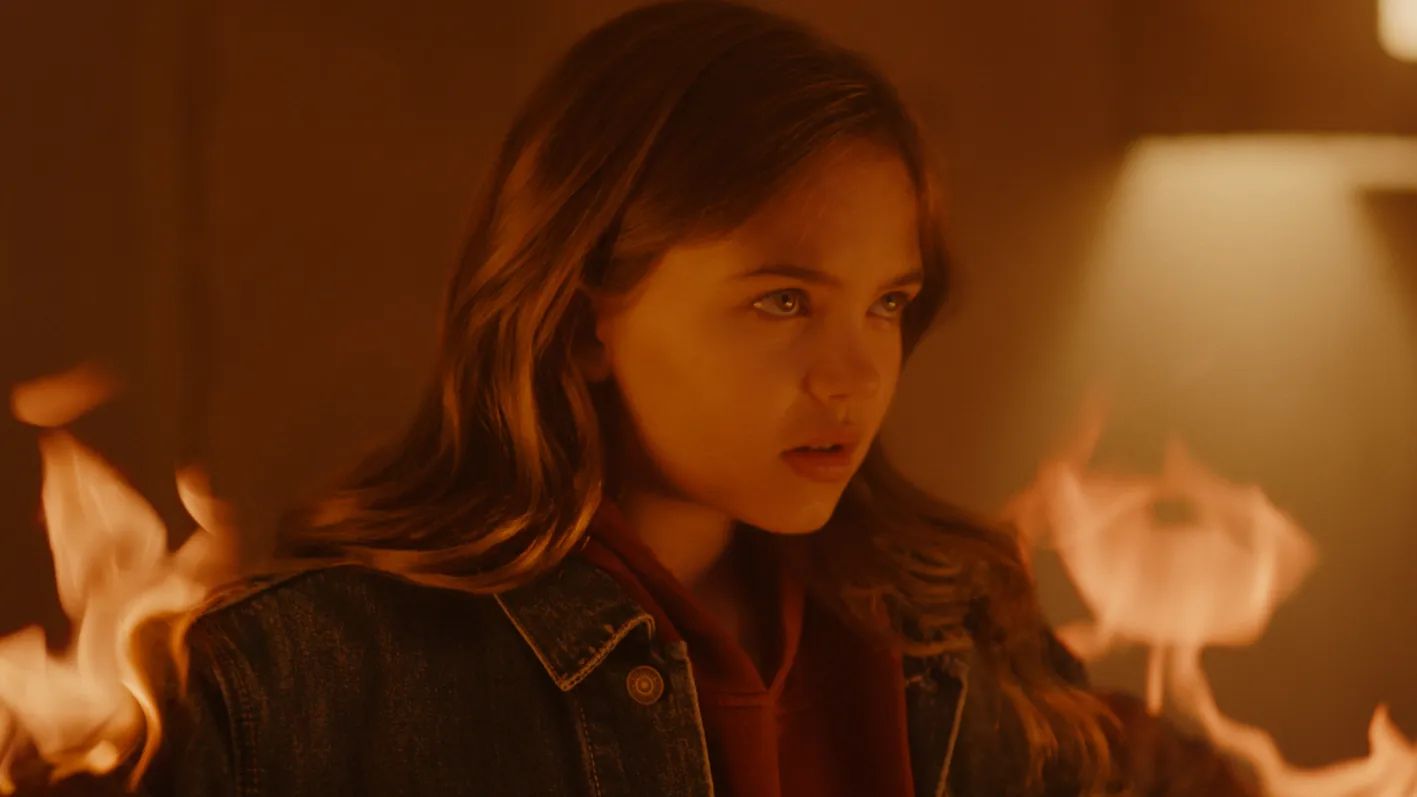 Firestarter is a strange beast with a difficult task: Retaining the core of the original story but not being to close too the orignal movie. Paying tribute to current political correctness, yet not changing the original material too much. For most of the time, they do fine, I’d say. Some changes did catch my eye: the conflict between the parents wasn’t there, as far as I remember, in the original movie. The mother wants Charlene to train so she can control her powers, the father would rather she suppress them, for who knows what may come out of them being released? In contrast, the original spent more time with Dad and daughter in the lab, the evil Rainbird slowly gaining Charlie’s confidence in order to kill her when appropriate. It went more for slow menacing tension – also the approach of King’s novel – while this plays more as a “fugitives-on-the-run” scenario.
Firestarter is a strange beast with a difficult task: Retaining the core of the original story but not being to close too the orignal movie. Paying tribute to current political correctness, yet not changing the original material too much. For most of the time, they do fine, I’d say. Some changes did catch my eye: the conflict between the parents wasn’t there, as far as I remember, in the original movie. The mother wants Charlene to train so she can control her powers, the father would rather she suppress them, for who knows what may come out of them being released? In contrast, the original spent more time with Dad and daughter in the lab, the evil Rainbird slowly gaining Charlie’s confidence in order to kill her when appropriate. It went more for slow menacing tension – also the approach of King’s novel – while this plays more as a “fugitives-on-the-run” scenario.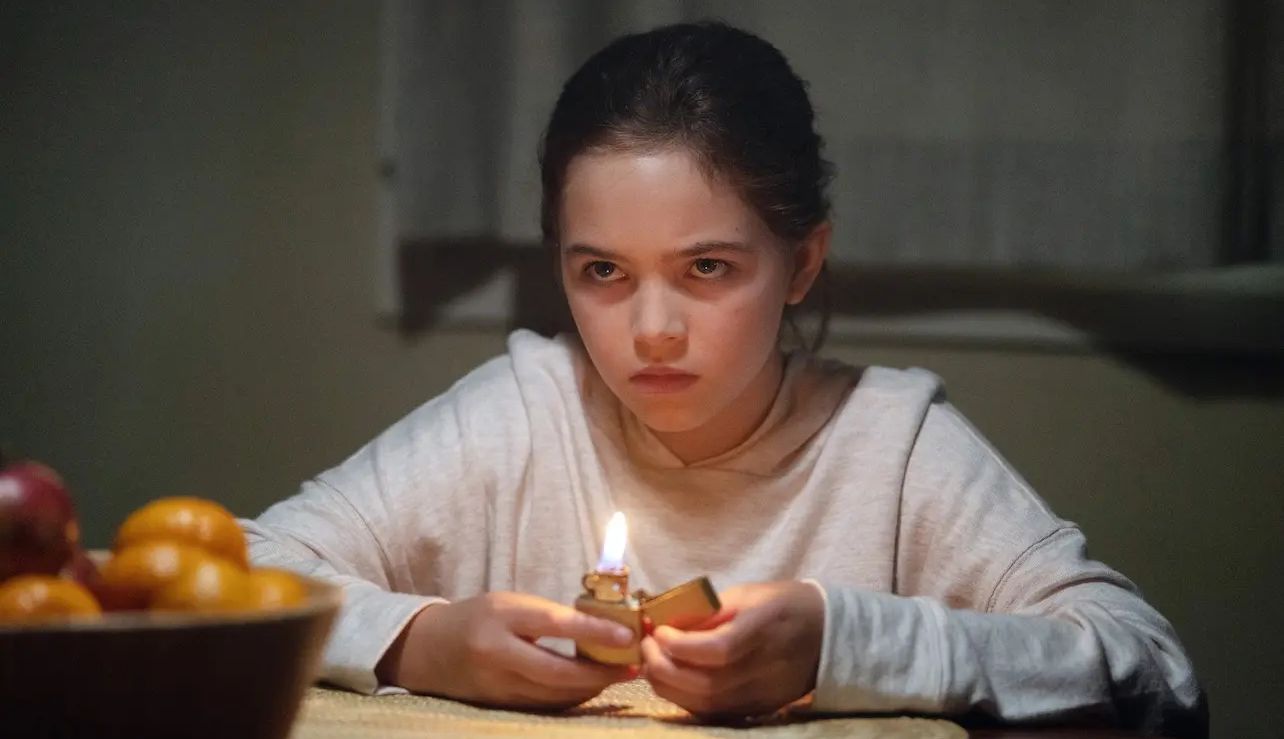
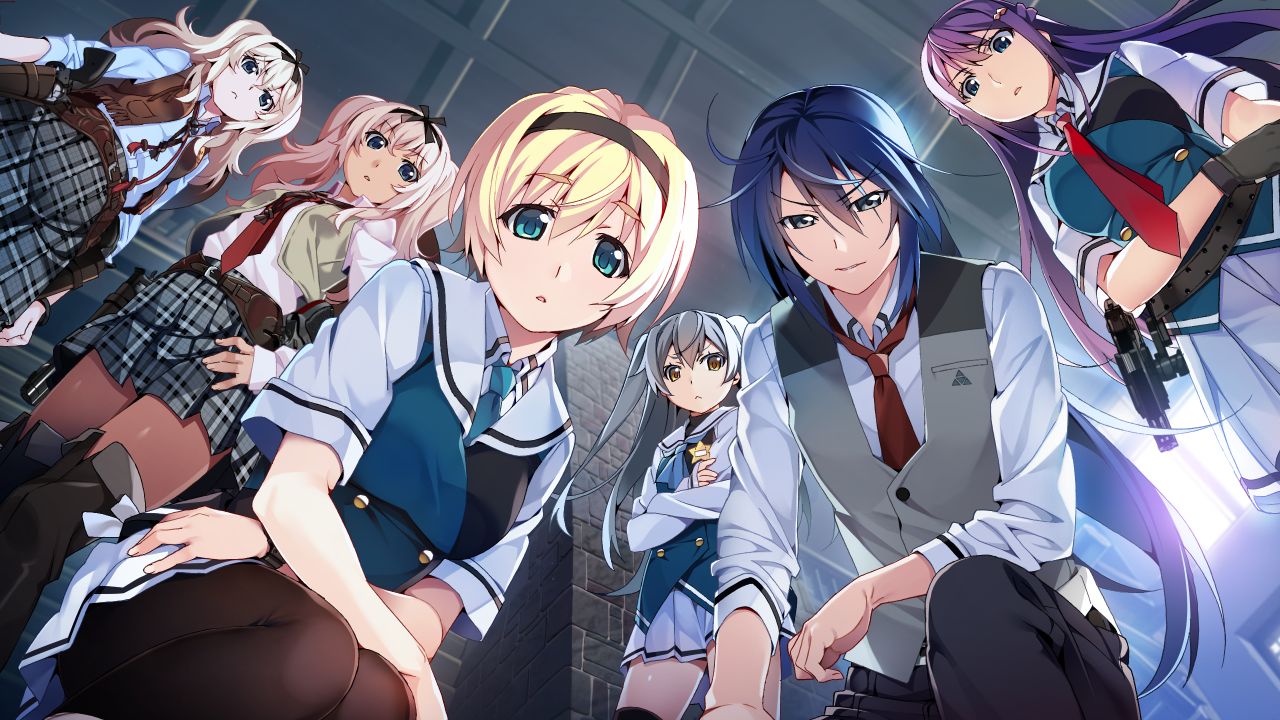 ★★★
★★★ So, what’s it all about? There was a US-Japanese anti-terrorism organisation called CIRS: after having become public knowledge, a new agency for covert operations was created, called SORD (Social Ops, Research and Development). This organisation has established many schools within the country, where homeless poor orphans from unfortunate backgrounds are being trained and schooled to protect the country (meaning: to kill people).
So, what’s it all about? There was a US-Japanese anti-terrorism organisation called CIRS: after having become public knowledge, a new agency for covert operations was created, called SORD (Social Ops, Research and Development). This organisation has established many schools within the country, where homeless poor orphans from unfortunate backgrounds are being trained and schooled to protect the country (meaning: to kill people). Though just 88 minutes long, this is very well done. The few short scenes of the childrens’ childhood give their fight more meaning then the talked about (but never really felt) conflict between for example 007 and 006 in GoldenEye. The fight itself is well-choreographed, looks believable (I’m very well aware I’m talking about an anime!), has exactly the right length and comes across as deliciously hard. And while the whole story about the stolen heart is solved in the end, I liked that this movie doesn’t end the way one would expect. The otherwise trigger-happy Rena
Though just 88 minutes long, this is very well done. The few short scenes of the childrens’ childhood give their fight more meaning then the talked about (but never really felt) conflict between for example 007 and 006 in GoldenEye. The fight itself is well-choreographed, looks believable (I’m very well aware I’m talking about an anime!), has exactly the right length and comes across as deliciously hard. And while the whole story about the stolen heart is solved in the end, I liked that this movie doesn’t end the way one would expect. The otherwise trigger-happy Rena 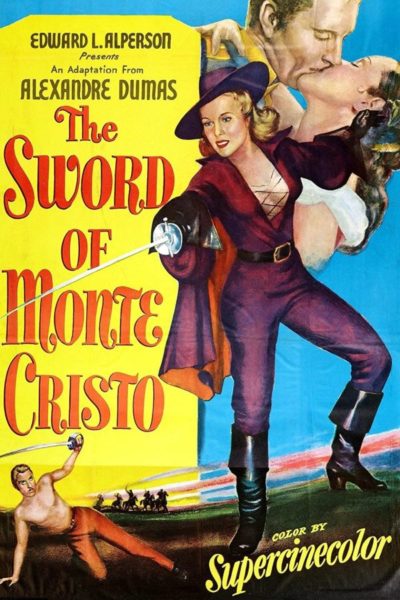 This 1951 movie is a bit clichéd. But then one has to consider that a lot of these weren’t clichés at the time the movie was made. That said, you will find everything here that you might expect from such a movie: A good king, his evil scheming brother who wants his throne, a dashing captain who has his way with the ladies, revolting citizens, a hidden treasure and a beautiful lady.
This 1951 movie is a bit clichéd. But then one has to consider that a lot of these weren’t clichés at the time the movie was made. That said, you will find everything here that you might expect from such a movie: A good king, his evil scheming brother who wants his throne, a dashing captain who has his way with the ladies, revolting citizens, a hidden treasure and a beautiful lady.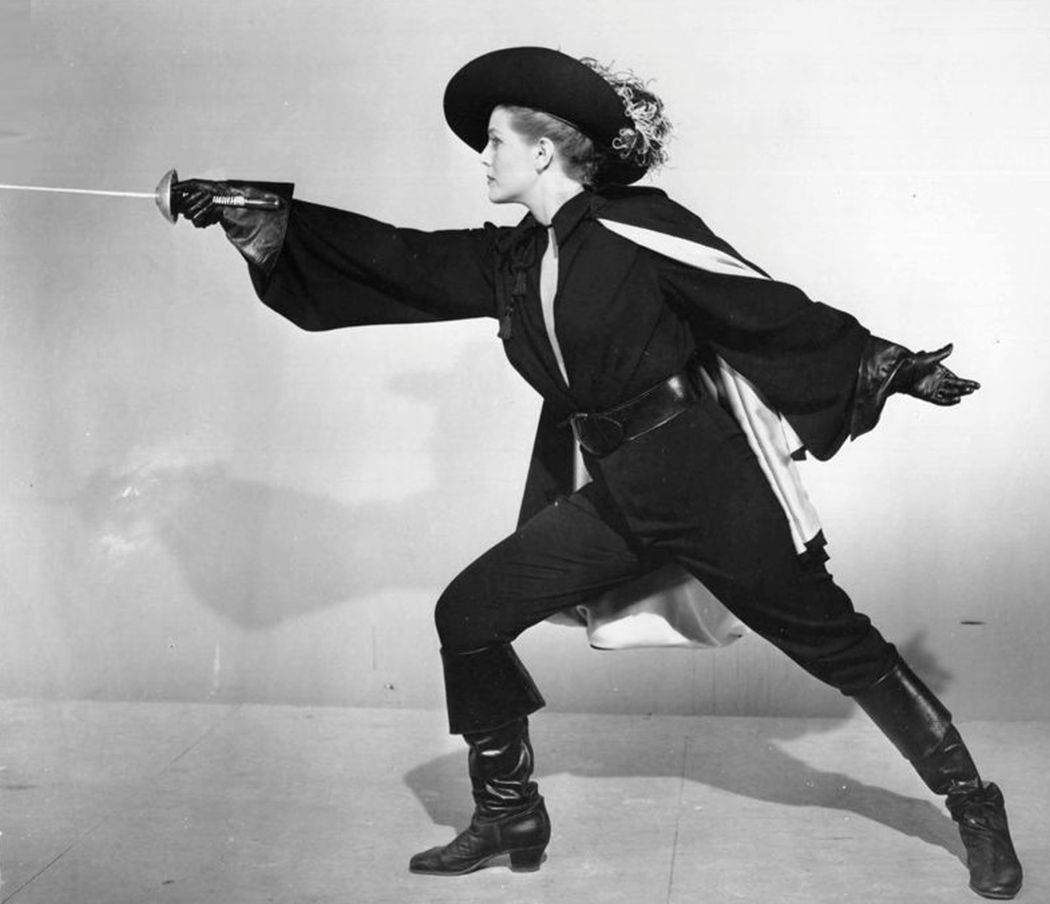 When he enters her private rooms, after she has just redressed as her normal self again, he takes – unasked – a seat and puts his shoes on the table. He also forces a kiss on Lady Christianne. When she snaps, “You don’t behave like a gentlemen should!“ he answers, “Well, you don’t behave like a woman should!“ You are left a bit baffled wondering how women in 1951 were supposed to behave when being kissed involuntarily, by an unknown stranger, who just entered your home through the window? But then even her nanny seems to agree (“A young lady shouldn’t run away from a man, she should catch one!”). How things have changed since that time!
When he enters her private rooms, after she has just redressed as her normal self again, he takes – unasked – a seat and puts his shoes on the table. He also forces a kiss on Lady Christianne. When she snaps, “You don’t behave like a gentlemen should!“ he answers, “Well, you don’t behave like a woman should!“ You are left a bit baffled wondering how women in 1951 were supposed to behave when being kissed involuntarily, by an unknown stranger, who just entered your home through the window? But then even her nanny seems to agree (“A young lady shouldn’t run away from a man, she should catch one!”). How things have changed since that time!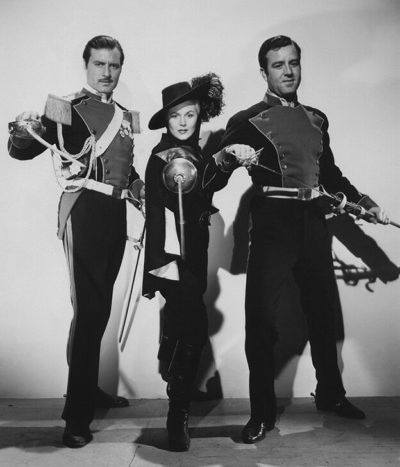 Countess Christianne does enough riding, fencing and chandelier-swinging to be rightfully included in the genre of female action heroines. Yes, she is not alone: Captain Renault comes across like a second-class Errol Flynn, supporting her and hinting as to her “true motives“ for cross-dressing and fighting (“You don’t fight against the king! I think, you are fighting against your female nature!“). Though Renault kills the big bad, she still has a mind of her own, riding with the Royal dragoons and killing off LaRoche’s right-hand man, Major Nicolet (Conrad).
Countess Christianne does enough riding, fencing and chandelier-swinging to be rightfully included in the genre of female action heroines. Yes, she is not alone: Captain Renault comes across like a second-class Errol Flynn, supporting her and hinting as to her “true motives“ for cross-dressing and fighting (“You don’t fight against the king! I think, you are fighting against your female nature!“). Though Renault kills the big bad, she still has a mind of her own, riding with the Royal dragoons and killing off LaRoche’s right-hand man, Major Nicolet (Conrad). I’m usually not a too big fan of trash movies, because a lot of them are not so much trashy, as they are boring. Nevertheless, I’m always in for a good, entertaining bit of trash, as long as I don’t find it
I’m usually not a too big fan of trash movies, because a lot of them are not so much trashy, as they are boring. Nevertheless, I’m always in for a good, entertaining bit of trash, as long as I don’t find it 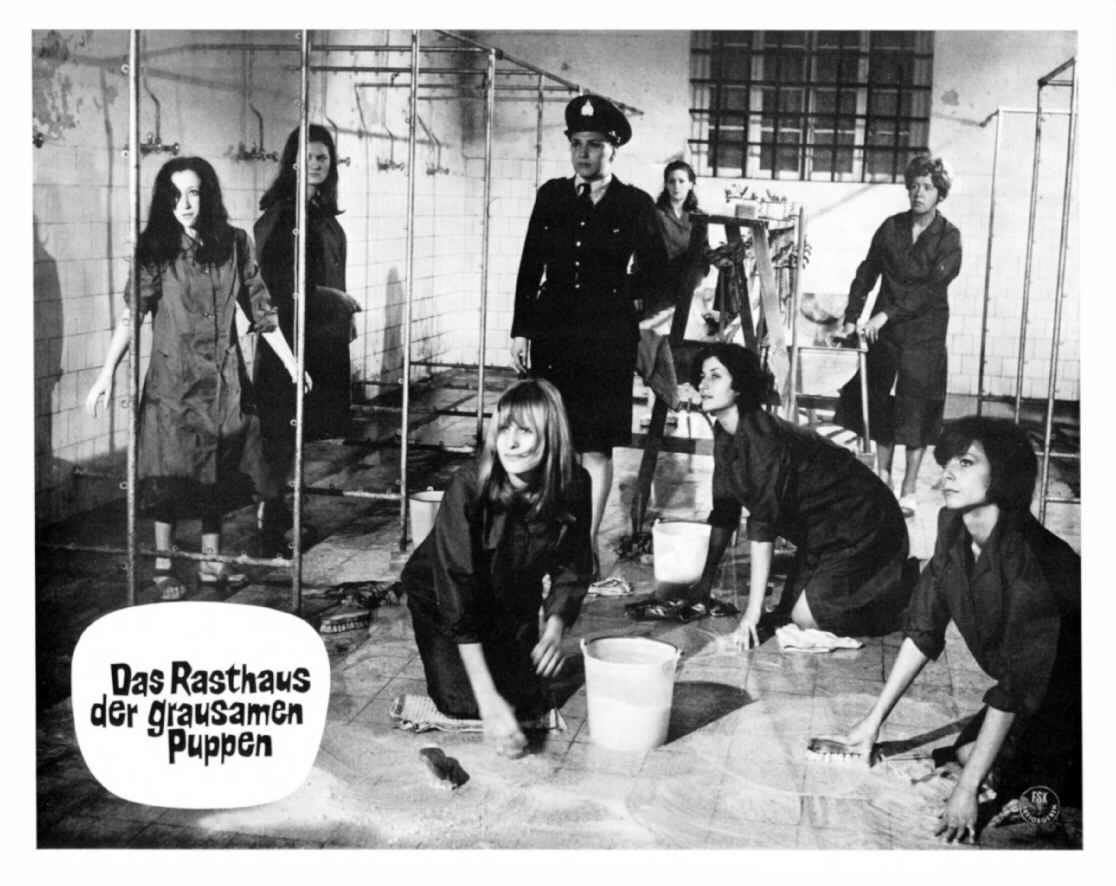 The setting and style – production design, costumes, cars – reminded me strongly of the Edgar Wallace movies. At the same time, you see women appearing as erotically as they could without ever being nude. Add to that the typical wooden acting of an Edgar Wallace movie, and you have an involuntary comedy of the highest order. I was screaming my head off because I found it hilariously stupid, especially when some of the actors tried to be “very emotional” and over-acted, without being able to be convincing. Also, I had to laugh at Betty killing off nearly everyone who has the misfortune to be in her line of fire. She is very trigger-happy and has a tendency to shoot first and ask questions… never.
The setting and style – production design, costumes, cars – reminded me strongly of the Edgar Wallace movies. At the same time, you see women appearing as erotically as they could without ever being nude. Add to that the typical wooden acting of an Edgar Wallace movie, and you have an involuntary comedy of the highest order. I was screaming my head off because I found it hilariously stupid, especially when some of the actors tried to be “very emotional” and over-acted, without being able to be convincing. Also, I had to laugh at Betty killing off nearly everyone who has the misfortune to be in her line of fire. She is very trigger-happy and has a tendency to shoot first and ask questions… never.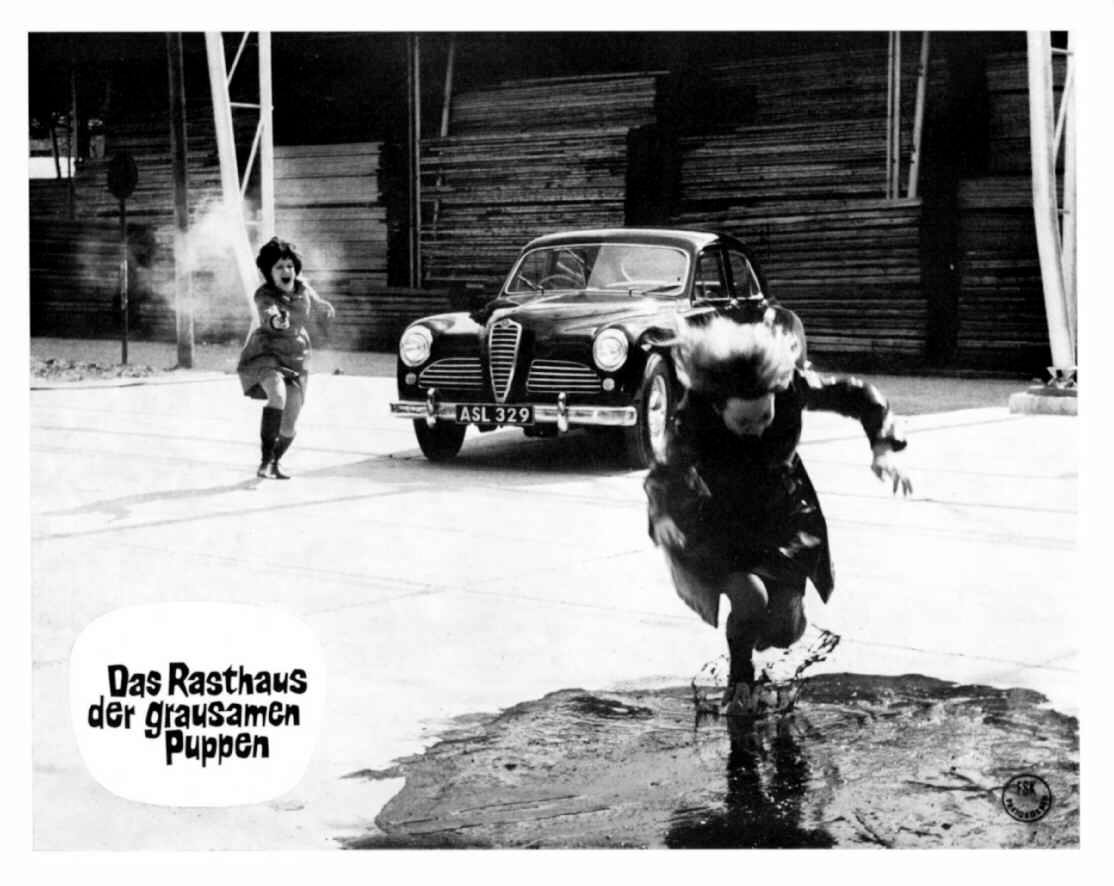 No, this is to be taken as seriously as long-running German TV series Hinter Gittern (Behind Bars), about a women prison. Which means: not at all! I always thought this genre came into existence in America in the 70s, having seen movies such as
No, this is to be taken as seriously as long-running German TV series Hinter Gittern (Behind Bars), about a women prison. Which means: not at all! I always thought this genre came into existence in America in the 70s, having seen movies such as 